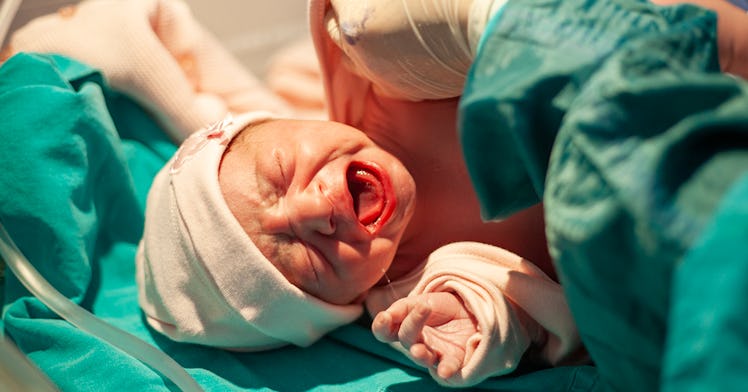Why ‘Lotus Birth’ Is A Pretty Terrible Idea
Keeping the placenta attached to the baby is an idea growing in popularity. It's also dangerous.

Cutting the umbilical cord — a father’s sacred duty (privilege? prerogative?) — has recently been supplanted by a more “natural” approach — leaving the cord uncut and the veiny placenta attached to the new baby long after leaving the hospital. This latest trend, dubbed “lotus birth,” is new enough that there are no statistics on its apparently growing popularity. But we do know it’s been around for some time and has caught on in very specific circles, encouraged in part by social media posts boosting the approach. We also know that’s it’s a potentially dangerous practice.
Health care professionals around the world have panned the practice and the Royal College of Obstetrics and Gynecologists issued a warning against attached placentas as far back as 2008. “There is currently no medical evidence that it is of benefit to the baby,” RCOG spokesperson Patrick O’Brien wrote in a statement. “If left for a period of time after the birth, there is a risk of infection in the placenta which can consequently spread to the baby. The placenta is particularly prone to infection as it contains blood. Within a short time after birth, once the umbilical cord has stopped pulsating, the placenta has no circulation and is essentially dead tissue.”
In 2013, vaccine denier and “free-range” parent Adele Allen described her experience with lotus birth as, “a lovely six-day period of bonding and closeness.” She went on to describing washing and wrapping the placenta, which was kept in a waterproof pouch. And perhaps it would be lovely if the placenta wasn’t literally a decaying organ crawling with disease.
“Why anyone with an understanding of modern microbiology would promote leaving a newborn attached to dead, decomposing tissue that could be a source of infection is beyond me,” obstetrician and gynecologist Jennifer Guntner told ATTN.
Of course, not all parents have even a passing understanding of microbiology and those that swear by the practice speak of it in less medical terms, claiming to feel a spiritual attachment to what is essentially decaying, diseased tissue. But an emotional urge to retain this piece of pregnancy shouldn’t be conflated with an evolutionary instinct. Nor should it be argued that cutting the umbilical cord too soon is bad for your baby.
To be fair, there is a partial trust in this line of thinking. Studies suggest delaying clamping by a couple of minutes can prove beneficial, and raise newborns’ iron and hemoglobin levels. For premature infants, that can be especially helpful. That’s why many physicians are now advocating for delayed cord clamping.
“The evidence of benefit from [delayed cord clamping] is so compelling that the burden of proof must now lie with those who wish to continue the practice of immediate clamping,” pediatrician Mark Sloan writes in Science and Sensibility.
But pausing for a beat before cutting the cord is not the same as waiting several days until the cord falls off by itself. The former constitutes sound medical advice that is free from the risk of infection and further complications. The latter decidedly does not.
This article was originally published on